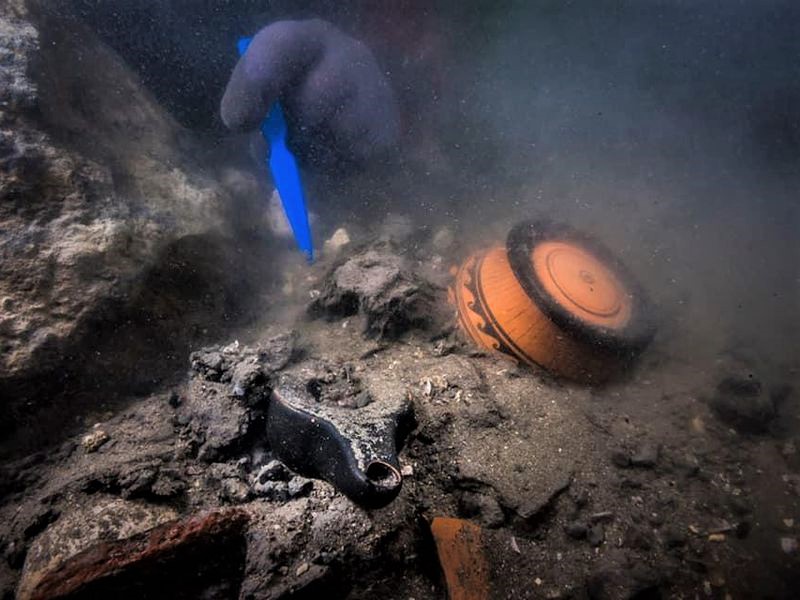
©Christoph Gerigk/Franck Goddio/Hilti Foundation
Pre-reading questions:
I will read each question. Then, please answer them.
- Do you like studying history? Why or why not?
- What discovery from the ancient time do you know?
Vocabulary:
I will read the words, meanings, and sample sentences. Then, repeat after me.
- prehistoric /pree-hi-STAWR-ik/
- harbor /HAHR-ber/
- vessel /VES-uhl/
- preserve /pri-ZURV/
- merchant /MUR-chuhnt/
[adjective] – describing the period before there were written records
The cave contained pieces of evidence of prehistoric livelihood.
[noun] – an area of water next to the coast, often protected from the ocean by a thick wall, where ships and boats can shelter
The wrecked ship has been towed into the harbor.
[noun] – a large boat or a ship
The cargo vessel arrived at Manila Port last night.
[verb] – to keep something as it is, especially to prevent it from decaying or being damaged or destroyed
Salt and spices can help preserve meat.
[noun] – a person whose job is to buy and sell products in large amounts, especially by trading with other countries
My late grandfather used to be a tobacco merchant.
Article reading:
Please read the whole article. Then, I will check your pronunciation and intonation.
Several prehistoric treasures such as Greek ceramics and 2,400-year-old fruit baskets were discovered under the sunken city of Thonis-Heracleion. It was the former largest Mediterranean harbor in Egypt before Alexander the Great founded Alexandria in 331 B.C.E.
Together with Egypt’s Ministry of Tourism and Antiquities, French marine archaeologist Franck Goddio and his colleagues at the European Institute for Underwater Archaeology (IEASM) unmasked the vessels. Exceptionally, these boats still contain doum nuts (fruits of an African palm tree) and grape seeds. Goddio believed that the fruits might have been preserved as funerary offerings since they were placed in an underground room. Not far away, the team also identified a 197- by 26-foot tumulus, or burial mound, and a grand collection of Greek funerary things. “Nothing was disturbed,” Goddio clarified. “Spectacular ceremonies must have taken place there. The place must have been sealed for hundreds of years as we have found no objects from later than the early fourth century B.C.E., even though the city lived on for several hundred years after that.”
Prehistoric pottery, bronze pieces, and figurines picturing the Egyptian god Osiris (also called Usir), were also discovered around the burial mound. According to IEASM, the discovery “beautifully illustrates the presence of Greek merchants and mercenaries who lived in Thonis-Heracleion, the city that controlled the entrance to Egypt at the mouth of the Canopic branch of the Nile.”
Together with Egypt’s Ministry of Tourism and Antiquities, French marine archaeologist Franck Goddio and his colleagues at the European Institute for Underwater Archaeology (IEASM) unmasked the vessels. Exceptionally, these boats still contain doum nuts (fruits of an African palm tree) and grape seeds. Goddio believed that the fruits might have been preserved as funerary offerings since they were placed in an underground room. Not far away, the team also identified a 197- by 26-foot tumulus, or burial mound, and a grand collection of Greek funerary things. “Nothing was disturbed,” Goddio clarified. “Spectacular ceremonies must have taken place there. The place must have been sealed for hundreds of years as we have found no objects from later than the early fourth century B.C.E., even though the city lived on for several hundred years after that.”
Prehistoric pottery, bronze pieces, and figurines picturing the Egyptian god Osiris (also called Usir), were also discovered around the burial mound. According to IEASM, the discovery “beautifully illustrates the presence of Greek merchants and mercenaries who lived in Thonis-Heracleion, the city that controlled the entrance to Egypt at the mouth of the Canopic branch of the Nile.”
Comprehension questions
I will read each question. Then, please answer them based on the article.
- How old are the discovered fruit baskets in the sunken city, according to the article?
- Who was the French marine archaeologist that led the mission?
- From what institute are the researchers who conducted the mission?
- What is an African tree’s fruit called?
- According to the French archaeologist, what were the preserved fruits for?
Discussion questions
I will read each question. Then, please answer them.
- What do you know about the prehistoric time of your country?
- What ancient discovery has struck you the most? Please share something about it.
- Which country’s history would you like to study? Why?
- What comes to your mind when you hear the word “ancient”?
- Are discoveries like this important? Why or why not?